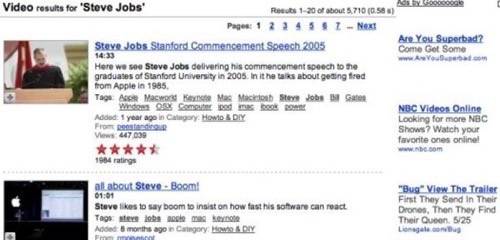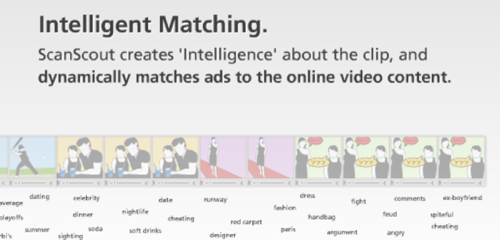
Duncan Riley at TechCrunch recently wrote a series of posts on video advertising. Also our own Sean Ammirati wrote a very interesting post yesterday, calling for an open ad network to compete with Google. Duncan’s most recent post profiles a new service called ScanScout, which claims to work similar to Google’s AdWords but for video. Google itself was recently profiled too, because it rolled out the first advertising solution for YouTube. If video is indeed the most important type of user generated content today, and we have entered the monetization phase of the new web, then the gold rush fever surrounding video ads is not a surprise. But what is the right way of doing this?
The right way is going to be whoever manages to deliver ads in a format that does not annoy consumers. A repeat of what Google did with text ads, but in video, is going unlock huge advertising spending and shift even more of it online. Will this be Google or some other company? We do not know yet, but Google has already spent a whooping $1.65B on YouTube, so it will fight this battle hard. In this post we look at what different companies are doing today and consider the ingredients of a successful solution, using AdWords as a model.
Why is AdWords so successful?
The key factors that make AdWords so successful are:
- Unintrusive: Users do not mind the ads;
- Simple: Most basic format possible;
- Useful: Users click on them;
- Relevant: Based on the text in the page;
- Easy to setup: Turn-key deployment for any site;
- Wraps content: Added on top of the content.
Another way to look at these key points is this. The first two bullets solve the Format problem, because as it turns out people do not mind text ads. The third and fourth bullets address the Relevancy problem – the reason people click on the ads is because they find them interesting in the current context. Last but not least, the last two bullets address the Technology Problem – a methodology for delivering ads. Now let’s look at how these issues are being addressed in video advertising.
Mapping AdWords to video
What should the format of the video ads be? There are several choices ranging from text ads, to logos (images) and video. Intuitively, if text ads were great for text, then video ads should be great for video. But that is not obvious. A major difference is that the text ads that Google delivers are clearly separated from the content. In the latest video-in-video ads, the content and the ads are mixed. Whether it is a pre-roll or post-roll or even an embedded video ad that user clicks on, the clean separation between content and the ad is gone. It is probably for this reason that pre-roll and post-roll solutions are not gaining in popularity.

It is also unclear whether text ads in video can work. Users do want to read while they are watching a video (if they did, more money in the US would be pumped into books instead of TV). Perhaps showing text ads next to the video might work, but that seems trivial and also is not as easy to implement for video. Image ads have a similar issue – they are too much like banner ads and seem underwhelming. So all and all, the advertising format problem is far from being solved for video. It’s likely though that video ads will be video, because it is a natural fit – it’s just that the nuances need to be worked out.

How can video ads be relevant? This second issue is actually even more difficult than the first. To understand why, consider how AdSense context-sensitivity works. Google’s algorithms analyze each piece of content using various types of statistical frequency analysis. They also do the same with ads and then match the two. The key ingredient of relevancy is having enough information. For sparse pages, ads are not likely to be relevant.
The difficulty with video is that there is usually no text (i.e. metadata) that describes it and there is no magic converter (unless ScanScout is one) that can run through the video and output a description of what is in it. In other words, there is no good way of measuring relevancy. To solve this problem, video needs to be annotated manually. So instead of automation creating keywords, people need to do this manually. This is currently how Gotuit does it, for example.
The more accurate the keywords users or other people input, the higher the likelihood of a relevant advertisement. However, since manual annotation is time consuming and imprecise, it is at best a short-term solution and the core problem is still unsolved.
However a proprietary video player approach may go some way to solve the issue of ad relevancy in video. This is where adverts are wrapped around the video, within a proprietary player – both ScanScout and AdBrite use this approach. It facilitates content wrapping and ease of use, and delivers a means of replicating videos – making it easier to virally spread videos on social networks.
Clearly these are early days and video player technologies will continue to evolve, but even today we are witnessing flexible solutions that mimic AdWords in terms of content treatment and delivery. Let’s finish by reviewing the solutions we’ve discussed…
Online video advertising showdown
Conclusion
The race to figure out the best way to deliver video advertising is heating up. If Google nails it down first, it will effectively double its current lead in online advertising. If it is going to be a smaller player like ScanScout that solves it first, there is likely to be a big bidding war – including Google and the other big companies that want to take Google down. No matter what, one thing is for sure. As Duncan put it in his post about YouTube: the economics cannot be avoided. That means there will eventually be some kind of advertising in most online video clips, whether we like it or not.





















